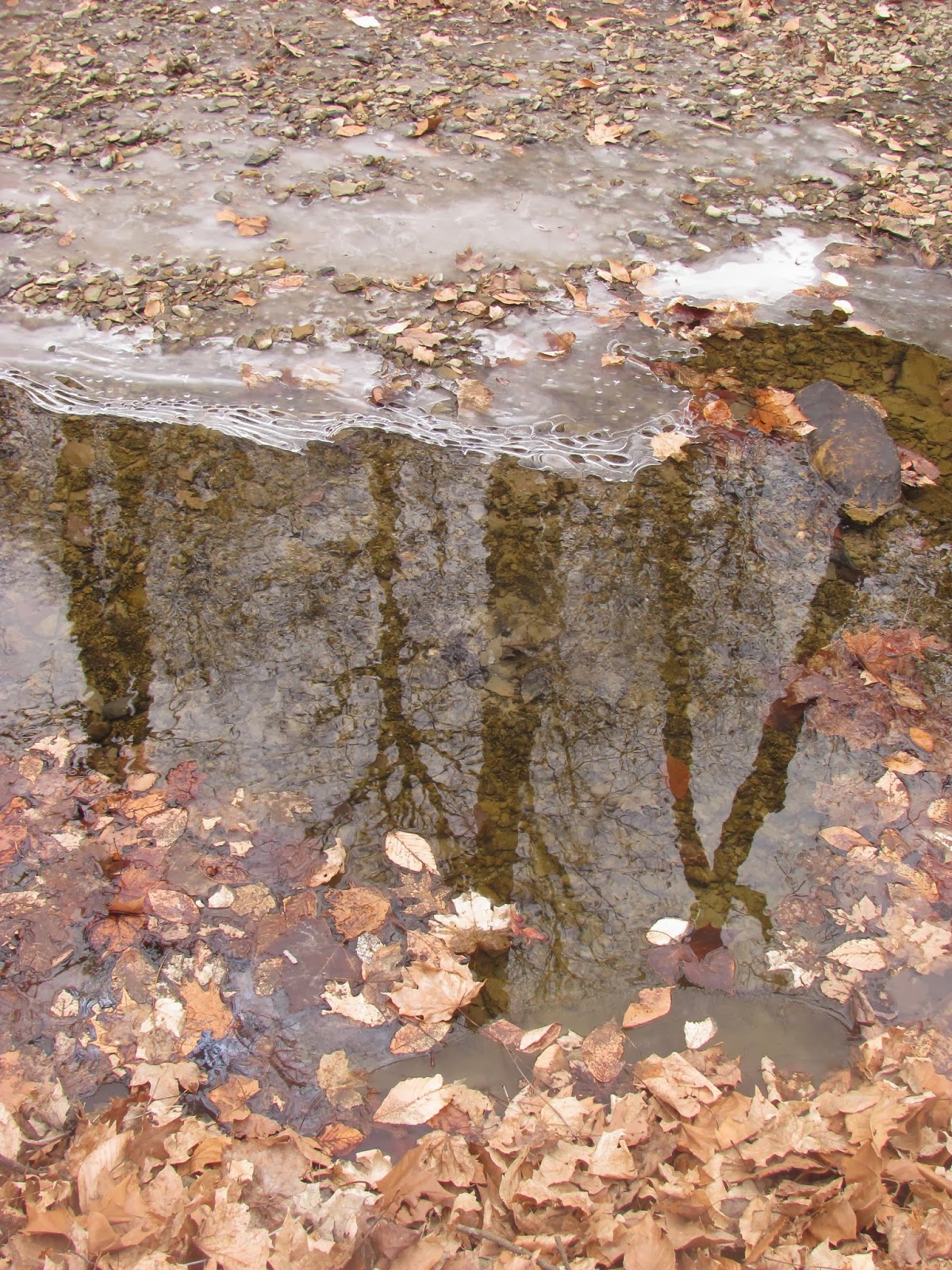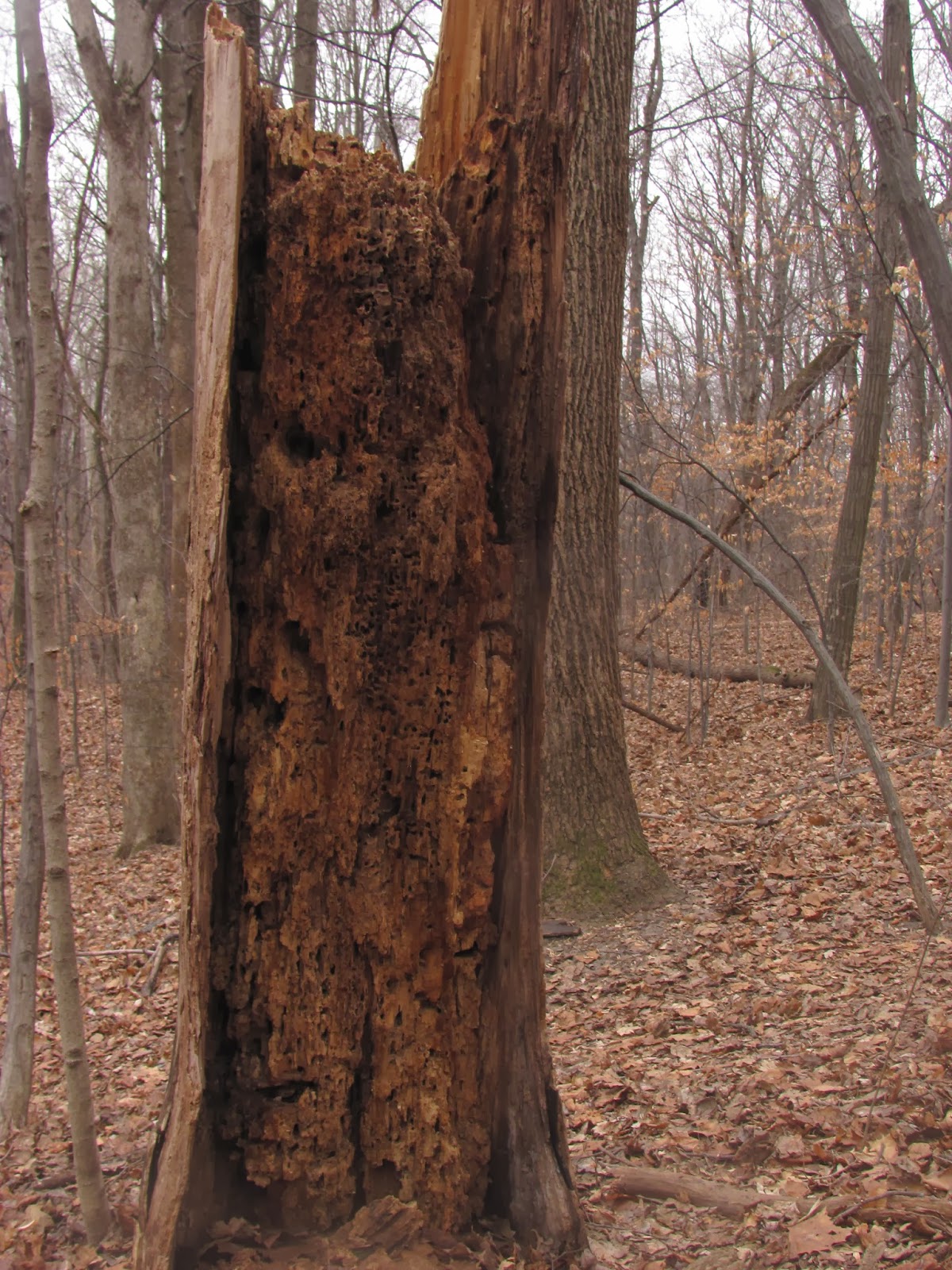Winter Design
Ouabache Trails Park
January 31, 2014
Those who will walk the woods only during the warm, green
season (or maybe, also, when the woods is ablaze with autumn color) miss the
extraordinary experience of the forest in wintertime. Each season has its own beauty and
surprises. Winter is especially
unique.
It is a calming experience to walk through a landscape that
shows its bare bones foundation, to be able to see details without cover or
adornment, when the presence of fewer colors allows us to see forms and lines
more clearly, when sounds are minimal and clear, and when the air is sharp and
awakening.
I went on a walk at Ouabache Trails Park two days before
Groundhog Day, when many animals are still in burrows or deep in mud, and
others are minimally active.
As I walked on through the woods, my boots made a sound like
a sharp tang as each step broke through icy crust on top of the snow.
This winter had already been colder than we had experienced
for some years in this area. Those
deeply cold, icy days, interspersed with occasional days of temperatures near
or above freezing, presented an ever-changing tableau of winter design.
To see it, one had only to go, and to look.
First, the Ice.
The variety of ways that water crystals arrange themselves is
incredible. Sometimes they form around
an object.
Sometimes they form in a mass, with no discernible pattern.
Patterns in ice tell the story of the flow of water, and
frozen moments.
Sometimes the story is of a glorious design, created, then
lost....
Water can freeze into phenomenal designs that look as it they
were created purposefully by an artist …
...and sometimes it creates seldom-seen phenomena.
Here, a thin layer of ice had formed over the frozen creek,
with a layer of air between. Water
condensed on the bottom of the upper sheet, creating these droplets.
Shattering ice sounded like the breaking of fine crystal,
unusually loud in the quiet winter air.
Natural designs that are barely noticeable in the loud
fullness of summer become more apparent this time of year.
The forest floor in winter is covered with a layer of dead
leaves in shades of brown and gray, and sometimes with a white layer of
snow.
Without an obscuring layer of tall plants, the intricate
intertwining of tree roots becomes obvious.
We can notice the texture, color and patterns of tree bark,
which become a good way to identify trees when they are devoid of leaves.
Sugarberry, or Southern Hackberry
Shagbark Hickory
Kentucky Coffee Tree
Persimmon
American Hornbeam (right) and Grape vine
With the leaves gone, the landscape takes on a very different
look. The shapes and colors of trees
become clear to see, including the smooth gray of American Beech and the
ghostly white top branches of Sycamore peeking through the otherwise brown
canopy. An intricate web of branches is
woven against a background of blue-gray sky, while rust-colored leaves of young
American Beech trees dot the understory.
Old Grape vines curve and angle through the whole scene.
A sharp, woody clap, like a child hitting a hollow tree with
a baseball bat, lets me know that the woodpeckers are busy in the trees over
the next hill.
The winter sun accentuates the skeletal canopy...
...while a russet ground cover softens the view below.
Looking up into the canopy is like looking into pen-and-ink
drawings.
The canopy of this Kentucky Coffee Tree is dotted with oval
seed pods still hanging on...
...but some of the pods are found below. The round seed
inside is easy to locate by the swelling on the pod. The pod's smooth, soft, white-dusted texture
contrasts with the sharply-veined, crackly leaves around it, making it easy to
spot.
The bean pod of another kind of locust tree, the Black
Locust, also lies on the forest floor, its long shape contrasting with the
rounded leaf shapes surrounding it. Many
small swellings along the pod belie the location of seeds inside.
Even in death, trees present a myriad of textures and
designs.
A blue-green smear of lichen can indicate an aging tree.
This live American Beech seems to be clasping a close
neighbor that has succumbed. The dead
Beech is riddled with holes made by woodpeckers who were searching for the
insects inside.
Another dead tree is almost nothing but holes. Its sloughing bark and layers of wood have
created different colors and designs.
The roots of this uprooted, long dead tree have become so
deteriorated that they have even hollowed and broken, creating homes for
wildlife.
Walking along the Trail 5 Loop, you can come upon a tall,
bark-covered stump. Stepping around to
the other side of the stump reveals a very different view, as if someone had
cut a vertical section to reveal the workings within. It has been almost completely eaten up by
various wildlife, resulting in an irregular honeycomb of tunnels, channels,
chambers and burrows.
In a closer view, you could mistake this for a sea sponge.
A wide variety of fungi can be found on dead and dying trees,
old stumps and rotten logs.
A bright white, cottony network of fungi mycelium can be
found within the leaf layer, helping to break down dead leaves, twigs, and
maple seed “wings”.
The cycle of life continues, even in the winter woods,
whether sprouting from old wood, old leaves, or the rich soil, providing spots
of green.
Bright green moss with dried sporophylls
Tightly curled moss, waiting for an increase in available
moisture
Liverwort, on a rock
face. It, too, waits for more moisture to be available in the form of rain,
melt water or humidity.
Graceful fronds of Christmas fern, which stays green all
winter.
Leaf of Puttyroot Orchid
Last year's dried plants add their own designs while carrying
seed for this spring's new growth.
Wood Mint
You only need to go, and to look.














































I love the idea of looking into a pen and ink drawing. I thoroughly enjoyed this stroll through the winter woods.
ReplyDelete